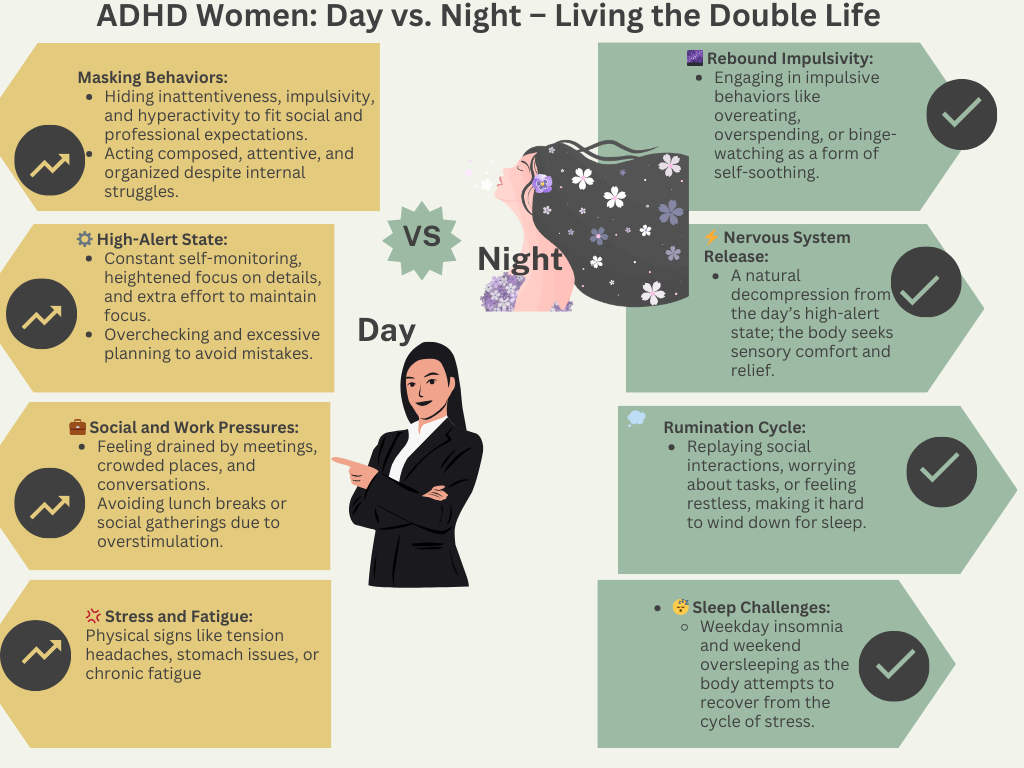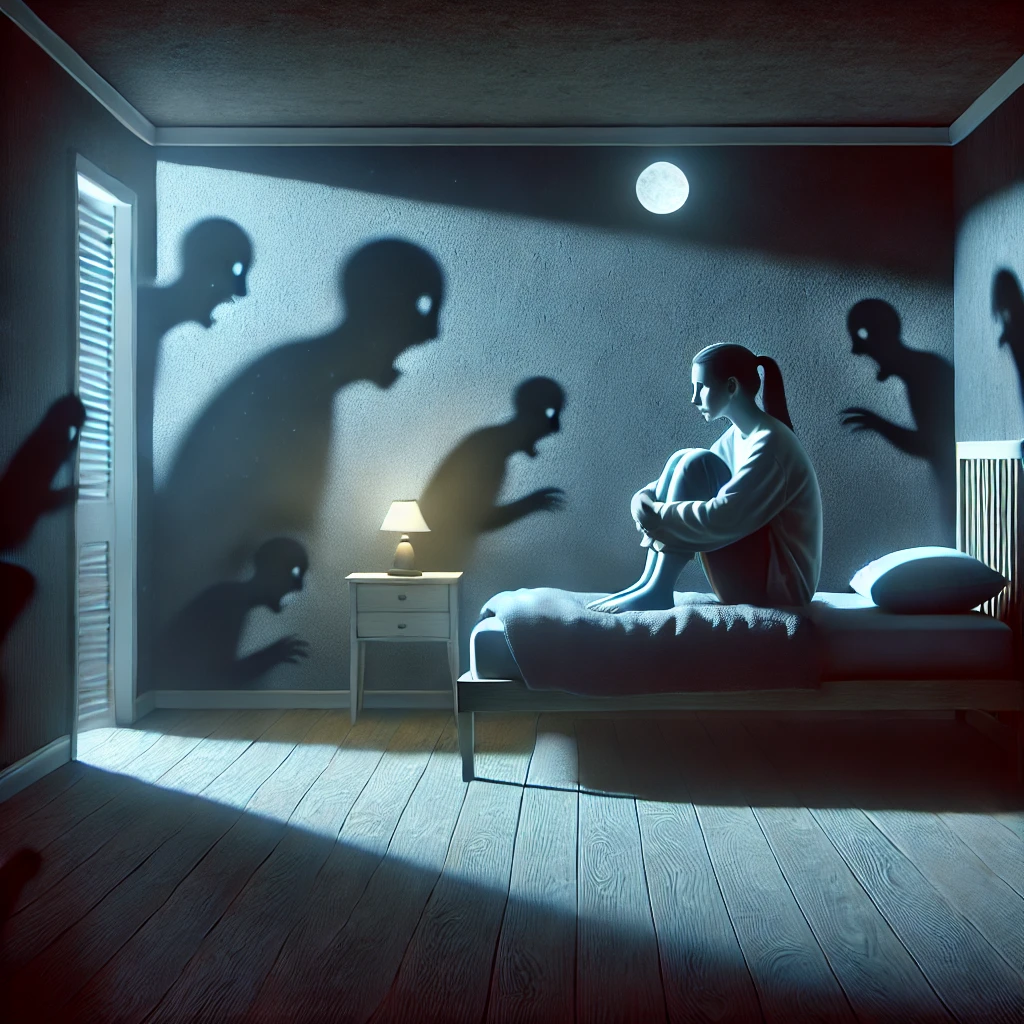Living a Double Life with ADHD: Why Day and Night Can Feel Like Two Different Worlds for ADHD Women
For ADHD women, life often feels like a balancing act between two different personalities. During the day, there’s a “public” self that strives to fit into societal norms, masking behaviors like impulsivity or inattentiveness to meet professional and social expectations. At night, though, the "private" self emerges, releasing built-up tension and often exhibiting traits masked during the day. This experience of shifting from one persona to another is a coping mechanism that helps ADHD women regulate and overload the nervous system.

🌞 Why Daytime Feels Like a Different World
For ADHD women, daytime often comes with pressures and stressful social interactions, overwhelming responsibilities, and expectations that require you to hide your true self.
We call this camouflaging or masking. It involves minimizing behaviors like hyperactivity, inattentiveness, or impulsivity to “blend in” or “fit in” within environments that expect specific standards of behavior and productivity.
Masking ADHD traits is exhausting and exhausting and takes incredible energy, focus, and constant vigilance.
While masking allows ADHD women to navigate day-to-day responsibilities, it also leaves them drained by the end of the day, with little energy for other personal or social commitments.
Reflective Question: How often do you find yourself masking during the day?
How does it feel when you finally release that tension?
✅ Personal Story: The Experience of Professional Masking
Annie, a coaching client, explained the impact of maintaining her “professional” self. She described her experience in meetings where she “nods along” and takes notes to appear engaged but often misses significant portions of the discussion. This meticulous focus on “appearing normal” leaves her entirely drained when she arrives home. She will shop, drink, or spend long hours on social networking sites to get reregulated.
Reflective Question: Does this feel familiar?
Do you ever feel like you’ve spent so much energy “appearing normal” that there’s nothing left for yourself by the end of the day?
🌌 The Nighttime Release: When the Mask Comes Off

As the day winds down and external demands lessen, ADHD women may start to experience a sense of release. Without the pressure to mask, impulsive behaviors might surface—things like snacking, online shopping, or binge-watching shows may serve as decompression tools. This isn’t about being careless; instead, it’s the body and mind’s way of “exhaling” after a day of self-restraint. ADHD women's nighttime routines often involve sensory comfort, relaxation, and activities that provide immediate satisfaction to recalibrate the nervous system.
Reflective Question: What do you notice about your habits or behaviors when you’re finally alone at night?
Can you see these patterns labaled as impulsive or destructive as attempts to help you unwind after masking during the day?
🧠 Scientific Insight: Understanding the Double Life ADHD Rebound Effect
Research on ADHD and self-regulation suggests a “rebound effect,” where impulsive behaviors resurface as a response to the sustained suppression experienced throughout the day. The ADHD brain, accustomed to being on high alert, seeks release through activities that provide instant gratification. This isn’t self-sabotage; it’s a coping mechanism to recalibrate after prolonged efforts to maintain focus and control. For some, these nighttime tendencies feel like part of a “secret life” filled with foods, habits, or interests they wouldn’t indulge in during the day, yet these are essential forms of decompression after a day of restraint.
Reflective Question: Do you ever feel like a different person at night?
How do these behaviors help you unwind?
💭 Rumination and Sleep Disruption: The ADHD Brain’s Nightly Challenge
For many with ADHD, the challenges of daytime pressures don’t end with the setting sun. Even after responsibilities wind down, the brain remains active, replaying the day’s events or worrying about future tasks. This rumination is more than simple overthinking; it’s the nervous system’s way of processing stress and unresolved experiences. This “high alert” brain state can lead to struggles with insomnia on weekdays, followed by hypersomnia (excessive sleep) on weekends when the pressure to perform is temporarily lifted.
Reflective Question: Do you find yourself lying awake at night replaying the day?
Are there recurring worries or thoughts that keep you up?
🚫 Increased Sensitivity in Social Settings
Social gatherings, such as group meals or crowded events, can be particularly challenging for people with ADHD. The heightened sensory sensitivity typical of ADHD means that environments with loud noise, many people, or constant movement can be overwhelming. ADHD women might feel overstimulated in these settings, and because of the attentional demands, such situations can feel draining. In these cases, even socializing can become an exercise in maintaining composure.
Reflective Question: When are you most comfortable in social settings?
Are there particular environments that feel especially overwhelming?
🔎 The Real Impact of the Double Life on Mental Health
Living a “double life” in this way can significantly impact mental and emotional well-being. The daily strain of masking ADHD traits can erode self-esteem, creating a sense of internal tension and leading to chronic stress and potential burnout. The energy spent on fitting into societal standards often leaves people with ADHD feeling disconnected from their true selves.
Reflective Question: How does the idea of a “double life” resonate with your experience?
Do you feel a disconnect between how others see you and how you see yourself?
💡 Bridging the Gap: Recognizing and Supporting the ADHD Experience
Understanding this double life is essential not only for individuals with ADHD but also for those around them. Reframing behaviors like impulsivity or rumination as responses to sustained stress allows for a more compassionate and understanding approach. This involves recognizing that:
- Self-compassion is critical, acknowledging that camouflaging is an adaptive response and nighttime release is a natural form of coping.
- Restorative practices, such as relaxation techniques, mindfulness, or decompression activities, can help one transition from high alert to relaxation at the end of the day.
- Supportive environments that embrace neurodiversity—whether through flexible work arrangements or sensory-friendly spaces—reduce the need for constant masking.
Reflective Question: How might self-compassion look for you at the end of a long day?
Are there different practices or supports that could make the transition easier?
Takeaway: Creating a More Supportive System for People with ADHD
Living with ADHD should not require living a double life. To truly support neurodivergent individuals, workplaces, schools, and society must adapt, incorporating neurodiversity-friendly policies that account for diverse ways of thinking, processing, and automation. This means fostering environments that lessen the need for masking by reducing sensory overload, offering flexible schedules, and creating inclusive spaces where individuals can thrive without hiding parts of themselves.
Reflective Question: What does thriving look like for you?
How might your life change if you no longer needed to mask your ADHD traits?
Other Pages of Interest on this Site



